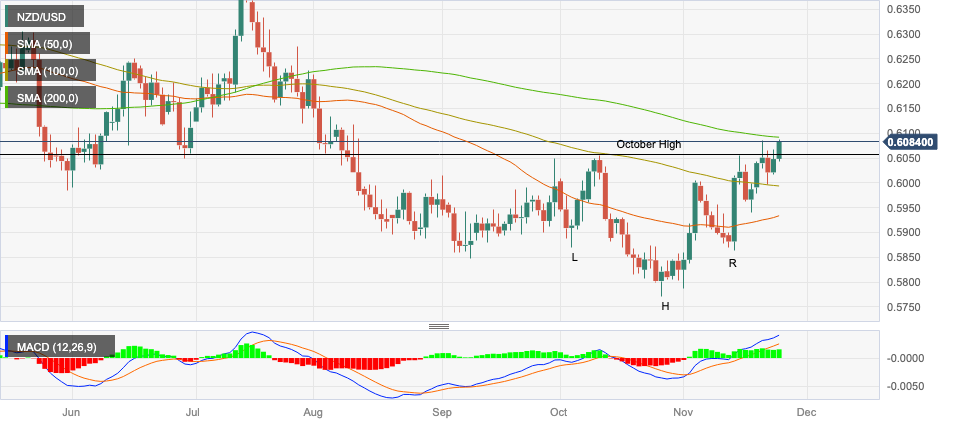New Zealand Dollar rises to intraday high late Friday
- The New Zealand Dollar continues cruising higher on broadly positive market sentiment.
- The Kiwi rises in line with global equities as Oil continues its downtrend and US PMIs come in mixed.
- NZD/USD ends the week on a high note, rising to within close proximity of the 200-day SMA at 0.6100.
The New Zealand Dollar (NZD) has risen to a daily high against the US Dollar (USD) at 0.6087 late in the session on Friday. NZD/USD is holding onto a 1.6% weekly gain on Friday as the positive market mood continues and a new government assumes power in Wellington, bringing weeks of coalition talks to a conclusion.
Market sentiment is finding a boost from falling Oil prices as OPEC+ countries argue over who should shoulder expected supply cuts. Meanwhile, in the US, according to inventory figures, Oil stocks are building, putting further downward pressure on prices. This comes as good news to cash-strapped motorists and businesses facing rising input costs. Global PMI data released during the week was overall positive, further elevating the mood.
As a commodity currency, the Kiwi is sensitive to changing perceptions of global growth and generally reflects investor sentiment.
Daily digest market movers: Bright market mood fuels New Zealand Dollar
- The New Zealand Dollar rises, benefiting from positive risk appetite amid declining Oil prices and upbeat macroeconomic data.
- Bad news regarding Chinese asset manager Zhongzhi, another fatality of the China property bubble, was not enough to raise significant concerns about the stability of the Chinese economy. Although the company announced it was insolvent with liabilities totalling between $58 and $64 billion, according to a report by Reuters, government intervention is likely to prevent contagion.
- "Financial regulators are almost certain to intervene aggressively if there's any sign that Zhongzhi's troubles are spreading," said Christopher Beddor, deputy director of China research at Gavekal Dragonomics, quoted by Reuters.
- Preliminary Purchasing Manager’ Index (PMI) data for November in the Eurozone and UK both showed better-than-expected performances. In the US, PMIs were mixed, with the Services index roundly beating estimates at 50.8 versus the 50.4 expected, but Manufacturing falling behind, with a reading of 49.4 after 49.8 was forecast.
- The center-right New Zealand National Party finally formed a government with its coalition partners, the populist New Zealand First party and libertarian ACT New Zealand, bringing almost six years of Labour Party reign to an end.
New Zealand Dollar technical analysis: NZD/USD breaks but does not hold above key resistance
NZD/USD – the number of US Dollars one New Zealand Dollar can buy – pushes back up to within a hair’s breadth of the 200-day Simple Moving Average (SMA) on Friday.

New Zealand Dollar vs US Dollar: Daily Chart
The pair is in a short and medium-term bullish trend, which continues to bias longs.
The 200-day Simple Moving Average at 0.6100 (just above the current market level at 0.6084) is likely to provide a major resistance level to further upside, so price will probably stall there at first contact.
The MACD momentum indicator is rising in line with price suggesting the uptrend is healthy.
A possible bullish inverse head-and shoulders (H&S) pattern may have formed at the lows. The pattern is identified by the labels applied to the chart above. L and R stand for the left and right shoulders, whilst H stands for the head. The target for the inverse H&S is at 0.6215. This adds more weight to the bullish argument.
The long-term trend is still bearish, however, suggesting a risk of a recapitulation remains.
RBNZ FAQs
What is the Reserve Bank of New Zealand?
The Reserve Bank of New Zealand (RBNZ) is the country’s central bank. Its economic objectives are achieving and maintaining price stability – achieved when inflation, measured by the Consumer Price Index (CPI), falls within the band of between 1% and 3% – and supporting maximum sustainable employment.
How does the Reserve Bank of New Zealand’s monetary policy influence the New Zealand Dollar?
The Reserve Bank of New Zealand’s (RBNZ) Monetary Policy Committee (MPC) decides the appropriate level of the Official Cash Rate (OCR) according to its objectives. When inflation is above target, the bank will attempt to tame it by raising its key OCR, making it more expensive for households and businesses to borrow money and thus cooling the economy. Higher interest rates are generally positive for the New Zealand Dollar (NZD) as they lead to higher yields, making the country a more attractive place for investors. On the contrary, lower interest rates tend to weaken NZD.
Why does the Reserve Bank of New Zealand care about employment?
Employment is important for the Reserve Bank of New Zealand (RBNZ) because a tight labor market can fuel inflation. The RBNZ’s goal of “maximum sustainable employment” is defined as the highest use of labor resources that can be sustained over time without creating an acceleration in inflation. “When employment is at its maximum sustainable level, there will be low and stable inflation. However, if employment is above the maximum sustainable level for too long, it will eventually cause prices to rise more and more quickly, requiring the MPC to raise interest rates to keep inflation under control,” the bank says.
What is Quantitative Easing (QE)?
In extreme situations, the Reserve Bank of New Zealand (RBNZ) can enact a monetary policy tool called Quantitative Easing. QE is the process by which the RBNZ prints local currency and uses it to buy assets – usually government or corporate bonds – from banks and other financial institutions with the aim to increase the domestic money supply and spur economic activity. QE usually results in a weaker New Zealand Dollar (NZD). QE is a last resort when simply lowering interest rates is unlikely to achieve the objectives of the central bank. The RBNZ used it during the Covid-19 pandemic.